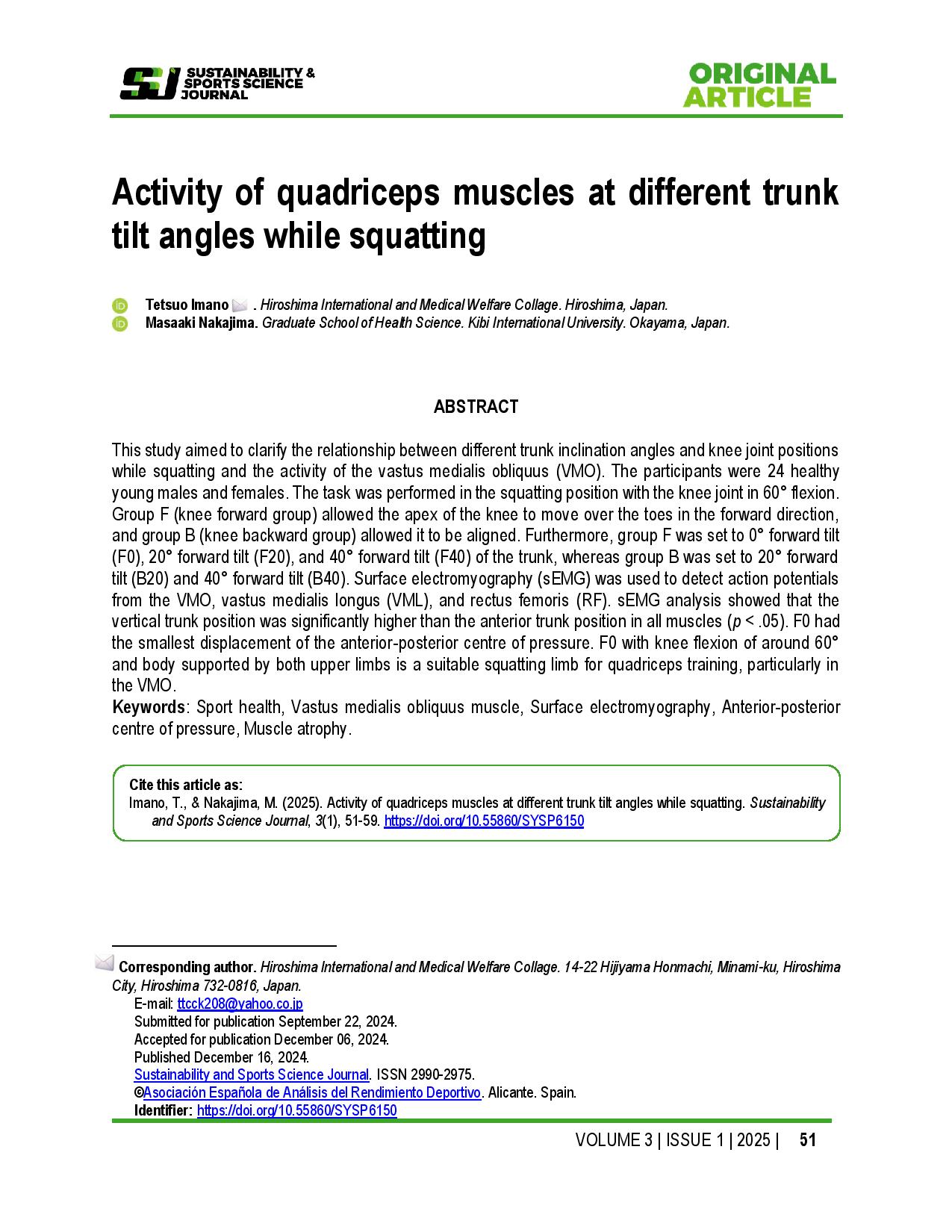Activity of quadriceps muscles at different trunk tilt angles while squatting
Main Article Content
Abstract
This study aimed to clarify the relationship between different trunk inclination angles and knee joint positions while squatting and the activity of the vastus medialis obliquus (VMO). The participants were 24 healthy young males and females. The task was performed in the squatting position with the knee joint in 60° flexion. Group F (knee forward group) allowed the apex of the knee to move over the toes in the forward direction, and group B (knee backward group) allowed it to be aligned. Furthermore, group F was set to 0° forward tilt (F0), 20° forward tilt (F20), and 40° forward tilt (F40) of the trunk, whereas group B was set to 20° forward tilt (B20) and 40° forward tilt (B40). Surface electromyography (sEMG) was used to detect action potentials from the VMO, vastus medialis longus (VML), and rectus femoris (RF). sEMG analysis showed that the vertical trunk position was significantly higher than the anterior trunk position in all muscles (p < .05). F0 had the smallest displacement of the anterior-posterior centre of pressure. F0 with knee flexion of around 60° and body supported by both upper limbs is a suitable squatting limb for quadriceps training, particularly in the VMO.
Article Details

This work is licensed under a Creative Commons Attribution-NonCommercial-ShareAlike 4.0 International License.
References
Charette, S. L., McEvoy, L., Pyka, G., SnowHarter, C., Guido, D., Wiswell, R. A., and Marcus, R. (1991). Muscle hypertrophy response to resistance training in older women. J Appl Physiol, 70 (5), 1912-1916. https://doi.org/10.1152/jappl.1991.70.5.1912
Elble, R. J. (1997). Change in gait with normal aging. In Masden, J. C., et al. (eds.): Gait Disorders of Aging (1st ed.). Lippincott-Raven, Philadelphia, 93-105.
Ezaki, O. (2012). Mechanisms for Anti-sarcopenic Effectsin Endurance Exercise and Resistance Training (in japanese), GAKUEN, 866:1-13.
Fry, A. C., Smith, J. C., Schilling, B. K. (2003). Effect of knee position on hip and knee torques during the barbell squat. J Strength Cond Res, 17(4):629633. https://doi.org/10.1519/1533-4287(2003)017<0629:EOKPOH>2.0.CO;2
Fujiwara, K., Ikegami, H. (1981). A study on the relationship between the position of the center of foot pressure and the steadiness of standing posture (in Japanese). Jpn J. Phys. Educ. Health Sport Sci,26(2),137-147. https://doi.org/10.5432/jjpehss.KJ00003392769
Gullett, J. C.,Tillman, M. D., Gutierrez, G. M., Chow, J. W.(2009). A biomechanical comparison of back and front squats in healthy trained individuals. J Strength Cond Res, 23(1), 284-292. https://doi.org/10.1519/JSC.0b013e31818546bb
Mündermann, A., Dyrby, C. O., D'Lima, D. D., Colwell, C. W. Jr., Andriacchi, T. (2008). In vivo knee loading characteristics during activities of daily living as measured by an instrumented total knee replacement. J Orthop Res, 26(9), 1167-1172. https://doi.org/10.1002/jor.20655
Nakamura, K., Ogata, T. (2016). Locomotive syndrome: definition and management. Clin Rev Bone Miner Metab, 14(2), 56-67. https://doi.org/10.1007/s12018-016-9208-2
Rosenberg, I. H. (1997). Sarcopenia: origins and clinical relevance. J Nutr,127 (5 Suppl), 990S-991S. https://doi.org/10.1093/jn/127.5.990S
Travnik, L., Pernus., F., Erzen,I. (1995). Histochemical and morphometric characteristics of the normal human vastas medialis longus and vastus medialis obliquus muscles. J Anat,187(Pt 2),403-411.




